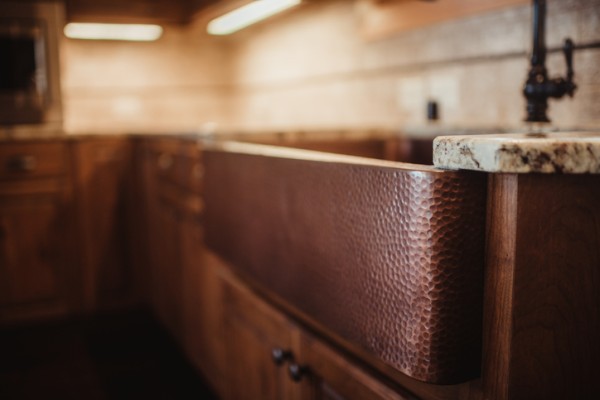
There’s something unmistakably warm and timeless about a copper farmhouse sink. The hammered finish, the rich glow that changes with time — it’s a feature that can elevate a kitchen from functional to unforgettable. But installing and maintaining one isn’t as straightforward as dropping in a standard stainless-steel basin.
Copper farmhouse sinks need careful handling from the moment they arrive on site. Their handcrafted nature, material properties and weight all introduce challenges that builders and home owners need to plan for.
If you’re considering one for your next new build or renovation, here’s what you should know about installation, potential pitfalls and long-term care.
What makes copper farmhouse sinks unique
Copper sinks are usually made from pure copper sheet, hand-hammered into shape to give that distinctive dimpled surface. The result is a sink that’s as much a design statement as a functional element.
Unlike coated materials, copper develops a natural patina over time — a thin oxidised layer that protects the metal and gives it character. Depending on how it’s used, this patina can range from deep bronze to rich reddish-brown or even greenish tones in certain conditions.
This organic finish is what makes copper so appealing to many home owners. Every sink tells its own story as it ages. But it’s also what makes these sinks more sensitive to how they’re installed and maintained.
Installation considerations
Copper farmhouse (or “apron-front”) sinks differ from traditional drop-in or undermount basins because they sit proud of the benchtop, with the front face exposed. This design adds visual weight (and actual weight) to the kitchen.
Here’s what to consider before fitting one:
1. Support structure
Copper sinks are heavy, particularly the thicker 14 or 16-gauge models. The weight increases significantly once the basin is full of water.
Unlike stainless steel, copper is soft, so the sink’s base can flex if not properly supported. Installers should:
- Build a reinforced support frame under the sink opening. This typically involves a solid plywood base or structural rails across the cabinet.
- Ensure the frame can handle not just the sink’s static weight but dynamic loads during use.
For existing cabinetry, it’s wise to check the base strength before installation — many standard cabinets aren’t designed for this kind of load.
2. Sink dimensions and cut-out
Copper farmhouse sinks are often hand-made, which means no two are exactly identical. Even models of the same nominal size can vary by several millimetres.
Always measure the actual sink before cutting cabinetry or benchtops. Use a template made from the sink itself, not a printed or generic one from the supplier.
Also, note that hammered finishes often feature slight waviness or irregularity along the top edge, this isn’t a defect, it’s part of the appeal. But it means your benchtop needs a forgiving silicone seal rather than a hard mechanical joint.
3. Benchtop compatibility
Copper farmhouse sinks work best with solid surfaces like timber, stone or composite benchtops. Laminates can be used, but extra care is needed to protect edges from water ingress.
Because the front apron of the sink overhangs the cabinet face, it’s important to plan the sink reveal early in the design phase. Builders should account for the apron’s thickness so it sits flush with adjoining doors or drawers.
4. Drainage and slope
The soft nature of copper means it can flex slightly under weight. That’s why factory-made copper sinks often have a slight internal slope to encourage drainage.
However, if the base support isn’t perfectly level, water can pool in corners, leading to staining or mineral build-up. Use a spirit level during installation and check for even water runoff before final sealing.
Common issues to watch for
Even with careful installation, a few recurring problems tend to show up with copper farmhouse sinks. Understanding them early can save a lot of frustration later.
Colour inconsistency
Because copper patinas naturally, areas that see frequent contact with water, acids or detergents will age differently. This can result in lighter or darker patches, particularly around the drain or where dishes rest.
It’s not a fault — it’s part of the living finish. But home owners should understand that copper won’t stay one uniform colour forever.
Scratches and dents
Copper is a soft metal, so scratches and small dents are inevitable. The hammered texture hides minor imperfections well, but heavier impacts can distort the surface.
Using rubber or silicone mats in the base can help protect the sink without detracting from its look.
Reaction with chemicals
Acidic or abrasive cleaners can strip the patina and cause bright, raw copper spots. This includes lemon juice, vinegar, bleach, and some dish soaps.
Once stripped, those spots will repigment over time, but it can take weeks to blend back in.
Maintenance for home owners
Copper sinks don’t require complicated maintenance, but they do benefit from gentle care and consistency.
- Daily cleaning: Use mild dish soap and a soft cloth or sponge. Rinse thoroughly after each use and dry the surface with a towel to avoid water spots.For sinks in hard-water areas, a quick wipe-down prevents mineral deposits and dull patches.
- Maintaining the patina: If you love the aged look, let the sink evolve naturally, just avoid scrubbing it with harsh pads or cleaners. Over-cleaning can interrupt the natural darkening process.For those who prefer a more uniform appearance, applying a thin layer of beeswax or carnauba wax every few weeks can help stabilise the patina and enhance water resistance. Many suppliers sell copper-specific waxes for this purpose.
- Dealing with bright spots: If acidic foods or spills lighten the copper, don’t panic. The area will darken again as it oxidises. To speed it up, dab the bright spot with a mix of water and baking soda or simply let time do the work.
- Avoid harsh chemicals: Steer clear of bleach, ammonia, vinegar, and abrasive powders. These will remove the protective layer and leave the surface uneven.
When to reseal or refinish
If a sink becomes dull or patchy after years of use, it can be rejuvenated with a professional refinish. This involves lightly sanding back the surface and applying a patina treatment before waxing or sealing.
It’s not something home owners should attempt with household chemicals — leave it to a metal-finishing specialist familiar with copper kitchenware.
The bottom line
Copper hammered farmhouse sinks bring undeniable charm and character to a kitchen, but they demand respect — both in how they’re installed and how they’re maintained.
Builders should allow for structural reinforcement, irregular dimensions and proper drainage. Home owners should embrace the living finish and commit to gentle care routines.
When done right, a copper farmhouse sink doesn’t just hold up under daily use — it grows more beautiful with age, becoming a centrepiece that reflects the rhythm of the home itself.




